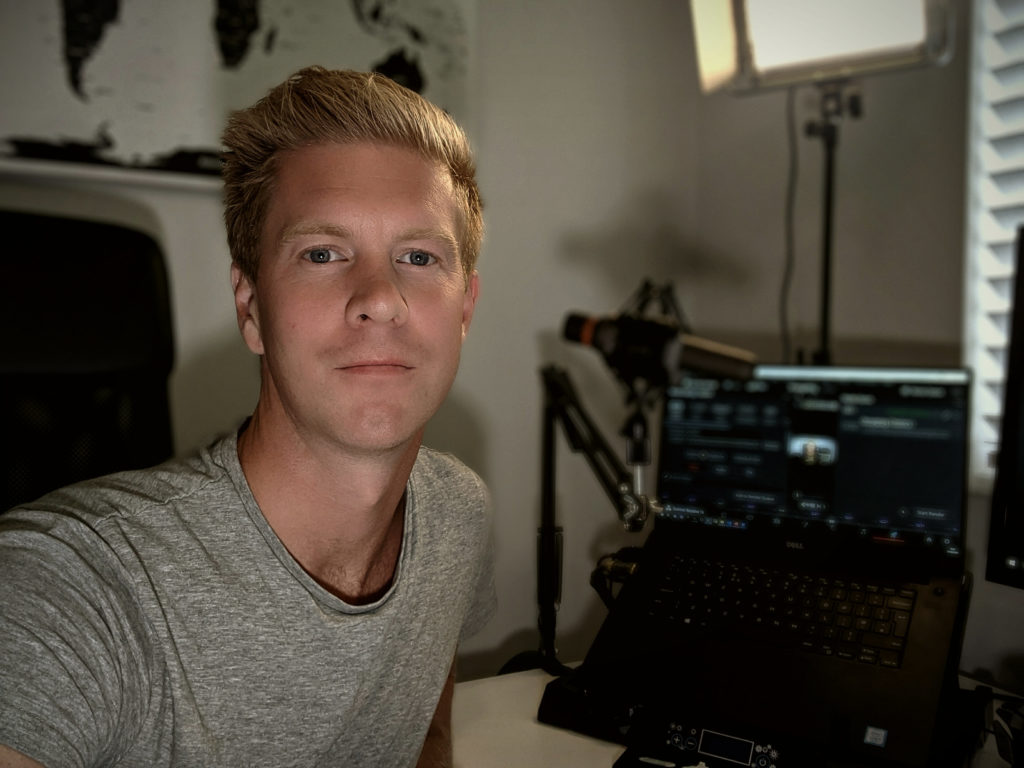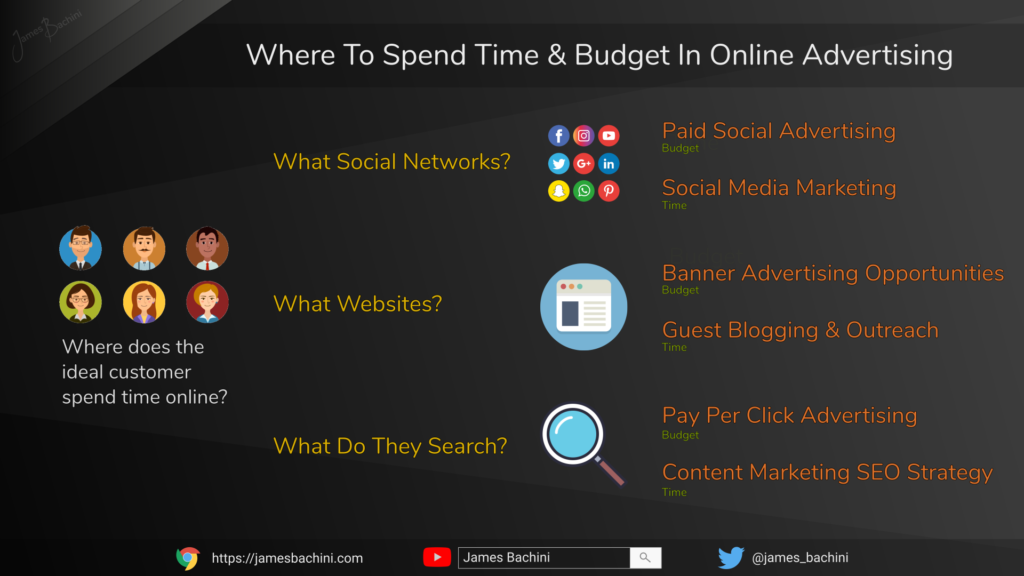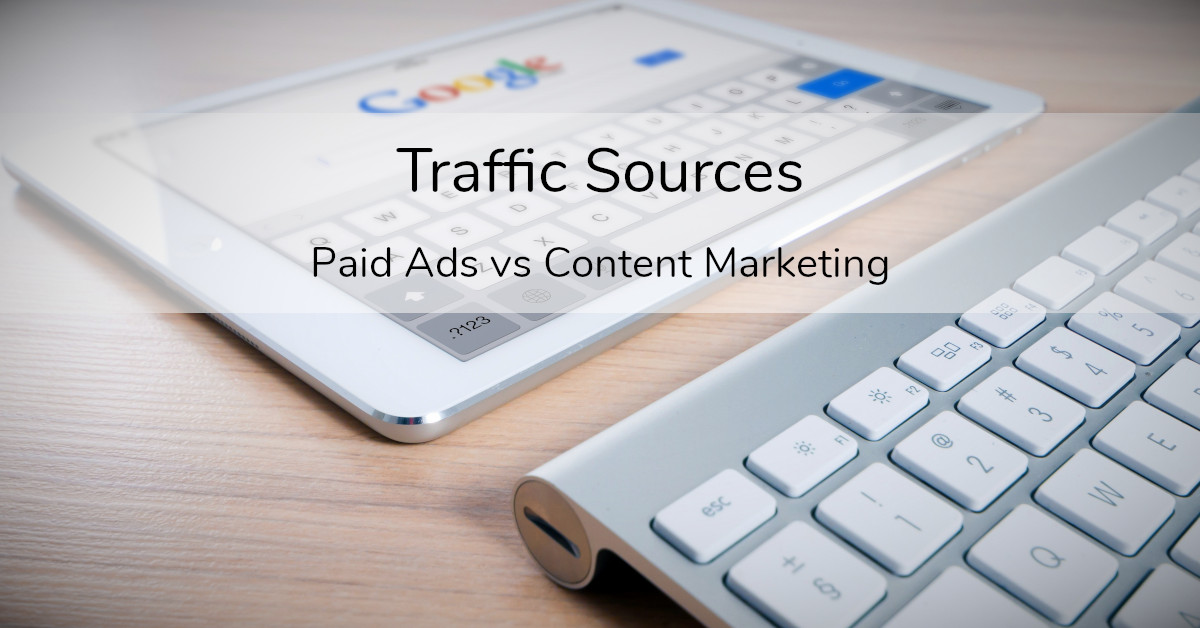This module is part of a free online course where you can learn digital marketing.
In this module we’ll be exploring the most effective traffic sources to drive more visitors and traffic to your website.
- Website Traffic Sources [Video]
- Paid vs Free Traffic – Expectations vs Reality
- Free Traffic Sources
- Paid Traffic Sources
- Where To Spend Online Advertising Budget
Website Traffic Sources

Paid vs Free Traffic – Expectations vs Reality
The expectation of most developers and startups is that they will build something great and it will go viral and take over the world. Time gets devoted to product development with no customer or user input. Marketing and monetization are normally afterthoughts.

Launch day comes and a social media post goes out. Then nothing happens. No one visits, the few who do happen across the product don’t return, there’s nothing even close to a viral coefficient and ultimately it turns out no one cares. The product gets added to the graveyard of bad ideas and dormant domain names.
Let’s pause for a second to look at this from a different angle. From a vantage point of traffic flow on the web. Visitors go from A to B and as they travel from web property to web property their attention carries value.
If a product can either generate traffic or monetize it then we can add value and create a profitable web property. More simply the lifetime value of a visitor needs to be greater than the cost of acquiring that visitor for the product will work.
If a product doesn’t generate significant revenues from the user base then it will be reliant on free traffic, such as ranking for the organic search listings in Google. An example might be a product that’s main monetization is through the selling of ads. There are very few arbitrage opportunities where marketers can pay for ads on one traffic source then add enough value to monetize that traffic effectively by selling ads.
Another consideration is whether free traffic is actually free. Free traffic takes a lot of time, effort and focus. Search engine optimization (SEO) for example is a competitive industry which takes a long time to develop. There are no guarantees that Google will favor your site over a new Forbes paid press release.
However focusing on free traffic sources is an investment of time for the future. By starting early you can build a content marketing strategy that will develop and grow slowly but surely into a consistent stream of traffic and brand awareness in your sector.
Paid traffic scales fast, can be optimized effectively and provides instant data and feedback. If you are building something new then running paid ads will get a seed audience and provide some much needed insight into conversion rates, customer sentiment and monetization potential.
For existing businesses paid traffic sources can be turned on by literally toggling a switch to generate new visitors to a product or service. Paid traffic sources are also competitive and the company that can monetize the traffic the best will ultimately be able to pay the highest cost per click and get the largest volume of visitors to grow their business.
Free Traffic Sources
SEO or Google traffic is what people think of first when it comes to a free traffic source. There are however other methods to generate organic traffic to a website.
Social media networks can be leveraged to build an audience and promote content. Youtube has become the default destination for video content and the best creators are enjoying huge organic reach. Email marketing and cold outreach when done well can get your product in front of potential customers for little to no financial cost.
All of these opportunities can be put together to form an effective content marketing strategy.
Content Marketing Strategy
Here are some considerations for creating a competitive content marketing strategy.
- Who is the content for? Building something for everyone only worked for Mark Zuckerberg and even he focused on college students first. Get a clear idea of demographic, interests and where those people spend their time online.
- What is the core value proposition? What is in it for your readers or viewers? Why would someone want to consume, like, share your content? Try brain storming one sentence to communicate how the content will add value for the audience.
- How is the content unique? Figure out what will make your content stand out from the other 2 million blog posts published that day.
- What channels will the content be published on? Publishing on your own site removes the reliance on 3rd parties but social media sites offer an existing audience.
- Can you create consistent content sustainably? Content marketing works best when content is released regularly over a long period of time.
- How will you gain initial traction and seed traffic? Finding 1000 true fans quickly through outreach or leveraging existing channels can save years of frustration.
Getting this clear from the outset will help focus efforts and ultimately make the content creation more worthwhile. These questions alongside exploratory ideas can be put down in to a Content Marketing Strategy document.
SEO – Search Engine Optimization
Google lists websites on it’s search engine results pages (SERPs). The top results are usually paid listings but below these is the organic or free listings. The process of getting a website to the top of the SERPs is known as SEO.

Things you need to know:
- SEO takes a long time. The average top result is 3 years old and there wont likely be any significant organic traffic in the first year.
- SEO requires backlinks. This is still a major factor and if no one is linking to your content then it wont rank.
- High volume, high value keywords are unrankable for new sites. In reality you aren’t going to get your website to the top of the search results if a big brand/news/magazine site already has a great piece of content focusing on that keyword term.
- SEO requires long-form content. Google ranks quantity over quality and long-form content such as 5000 word blog posts perform better than short concise answers to a search query.
If that doesn’t put you off then here is a complete guide to creating SEO Content.
Social Media Marketing
Social media networks have an existing audience that can be leveraged to gain organic traffic.
There’s very little organic reach on Facebook now. It has become pay to play for the majority of business use cases. The one exception to this is if you have a local business that might appeal to your “friends” and “friends of friends”. This however isn’t scalable.
Facebook is still the largest global social network and creating a business page makes sense as it’s easy to do and will be required if you ever want to advertise using Facebook Ads.
Very much a visual content platform where style and design are key. It is possible to build some organic traffic if your product is particularly suited to a younger audience and there’s a compelling reason for someone to follow your channel.
#Hashtags work well on Instagram as the most engaged users will often browser by subjects for particular hashtags.
Only useful for professional and mainly B2B products. Linkedin doesn’t have the most engaged community but it does provide ample organic reach.
There’s some example code here for how you can use browser automation to semi-automate your linkedin connections and network building: https://jamesbachini.com/browser-automation/
Twitter is a discovery network. People go on there to find new content and interact with new people. It’s used more for interest exploration and discussion rather than somewhere for posting family photos.
This makes it an ideal candidate for developing an audience and driving traffic.
TikTok
In 2020 nowhere has organic reach like TikTok. If brands can create compelling, engaging, short form vertical video content then it can distributed to a huge audience.
The TikTok demographic is younger and internet savvy so certain offers and products aren’t suitable. Content needs to entertain.
Reddit like all social networks takes some time to get going. The particular difference with Reddit is you need to participate in conversations and offer value to build “Karma” before you can post your content and links to external sites.
Many subreddits are highly moderated and skeptical of promotional content. Develop connections and make yourself known to the community before posting any form of communication which could be seen as spam.
Users on Pinterest are more open to content delivered from businesses and brands. Design and style are critical as it’s a visual platform. Demographic is skewed towards older female baby boomers.
Organic reach is good and DIY, Tips & Creative content tends to trend well.
Other networks worthy of a mentions are Telegram and Discord which are a form of chat room, Snapchat which has been outshadowed recently but still has a strong user base and Youtube which deserves a section of its own…
YouTube – Creating Video Content
There is no other channel which offers the same opportunity to build an organic audience as YouTube right now. Here are 6 reasons why:-
- YouTube is growing fast as the world moves towards digital TV
- YouTube videos are getting shown more and more on Google search engine results pages
- Video content is extremely powerful for connecting with visitors and establishing brand authority
- There is a barrier to entry where video content can’t be outsourced to developing countries like creating written content and visuals can
- You can generate revenue directly from your Youtube channel once it reaches 1000 subscribers.
- Video shows that there is clearly someone behind the site and provides a personal connection with the visitor and any Google manual reviewers assessing the authoritativeness of the site.
The challenge is creating good video content. This is easier and cheaper now than it has been in the past but is still a challenge and skill that can be improved over time
A good smart phone and $20 Boya M1 lav mic is all you need to get started. Davinci Resolve is a good free video editor. Try to create content that is either education or entertaining, the best channels are able to do both.
I’ve found the more videos I create the more comfortable I get in front of camera and slowly the quality of content improves. This is an ongoing learning process but something I’m focusing on this year for all the reasons above.

Email Marketing & Outreach
Decision makers at every level in every company still use and respond to email. There is no better method of outreach in my opinion.
If you are sending more than 100 emails a day then you’ll likely want to look into a SMTP provider such as Sendgrid or Mailchimp.
Email outreach can take many forms:
- Asking for links and social shares
- Building industry connections
- Offering an opportunity to add content to a piece in the form of a quote
- Offers to conduct interviews or podcasts
- Running cooperative offers and joint ventures
- Collaborating on a piece of content
Whatever you do focus on quality rather than quantity. It’s still a numbers game but a very personalized email will rarely get marked as spam whereas if you bulk send 100 emails just changing the “Dear ${firstname}” variable you’ll find everything starts getting redirected to the “junk” folder pretty quick.
Don’t be offended if someone doesn’t respond and accept that no one cares unless there’s something in it for them.
Paid Traffic Sources
If you can monetize incoming traffic effectively and your product scales well then this is where fast, exponential growth happens.
Paid traffic is purchased via ad networks which act as an exchange marketplace for publishers and advertisers to buy and sell digital ad space.
There are different formats of ads which work and convert differently. A disruptive pop under ad isn’t as valuable as a click from someone searching for exactly your type of product.
In this section we will go through and analyse some of the popular ad networks and formats.
Facebook Ads
Facebook Ads includes traffic from Facebook, Messenger and Instagram. This platform has targeting like no other and is a favorite for online marketers because of the ability to segment a very niche audience.
There’s a full module on the Facebook Advertising Network here:
https://jamesbachini.com/facebook-advertising-network/
Google Ads
Google Ads is the other online advertising giant that every digital marketer should know there way around. Traffic includes Google Search, Gmail, Youtube and 3rd party sites via the display network.
Google search campaigns are extremely effective if you can find low competition high value key words. The display network is rife with fraud but when optimized broad campaigns can scale to nose bleed volumes.
There’s another module dedicated to creating Google Ads here:
https://jamesbachini.com/creating-google-ads/
Display Advertising – Banner & Native Traffic Sources
Demand side platforms (DSP’s) allow media buyers to access the global interconnected networks of display advertising inventory.
Google is the biggest player in this market with their display network traffic and Adsense publisher network. Other networks worth testing are Sitescout, BuySellAds and Amazon Advertising.
Native networks such as Taboola and Outbrain have large inventories and blend ads into the content of the page to provide a more seamless user experience.
Banner ad networks are burdened with ad fraud so be careful how and where you spend advertising budget. Track conversions throughout the sales funnel and optimize accordingly.
The majority of banner ad networks now support video and HTML5 ads which tend to convert better and offer higher ROAS for advertisers.
Push Notification Traffic Sources
Have you seen one of these banners pop up recently?

That’s a push notification authorization. If you click “Allow” then it gives the advertiser or advertising network to send notifications in the form of ads directly to your browser.
Marketers can use networks such as RichPush and AdCash to send notifications to large audiences at a low cost.
Push notifications are a disruptive form of advertisement so need to capture attention quickly.
Pop & Interstitial Ad Traffic Sources
Pop under and interstitial ads are ads that open in a new tab. They are popular on low quality publisher sites where audience retention isn’t a priority.
Ad fraud should be expected as standard on every pop under ad network. Tracking micro conversions can help optimize out bad sources/publishers quickly.
Again pop-unders are very disruptive so the landing page that gets shown needs to capture attention to prevent getting closed a second after it loads.
Where To Spend Online Advertising Budget
This depends very much on the offer being promoted. Start with the customer and where they spend their time online. How would they most likely go about discovering your product and brand in an ideal world?
I would only recommend focusing on free traffic and content marketing if you are committed to a project for at least 3 years. It will take one year to develop an audience, one year to scale and in the third year you should see significant results. That’s a guideline more than a rule of course.
Paid traffic is great if you can afford it. If you can’t then look at how you are monetizing your visitors and figure out how the product will become competitive.
I’d recommend starting with Google search ads for most products and services. This will deliver visitors interested and actively searching in your niche.
Facebook ads should form a part of most commercial marketing strategies and budgets because of the advanced targeting and retargeting possibilities.
Only once comfortable with conversion tracking and optimization would I recommend moving on to other ad networks which can outperform but require more work to optimize.
All advertising networks and content strategies take time to master so it’s best to focus on the ones that you think will most suite your audience. If your ideal customer is a professional and you are selling a B2B product then it makes sense to focus on Linkedin as a primary traffic source.
Run tests, track conversion data and figure out what works as you go. When you find a pockets of profitable traffic then they can be scaled up by devoting more attention and budget to that area.

This article is part of a free online course where you can learn digital marketing.
If you’ve enjoyed these resources could you help share this content on social media and send it to anyone who you think might benefit from it.
Thank you.



